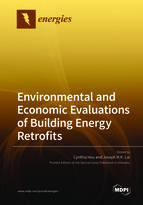Environmental and Economic Evaluations of Building Energy Retrofits
A special issue of Energies (ISSN 1996-1073). This special issue belongs to the section "G: Energy and Buildings".
Deadline for manuscript submissions: closed (28 April 2022) | Viewed by 14466
Special Issue Editors
Interests: building energy retrofits; facilities management; built environment management; smart technologies’ application in the built environment
Interests: building services design and construction; operation and maintenance for buildings; facilities economics and contract management; performance benchmarking and assessment; legislative controls on built facilities
Special Issues, Collections and Topics in MDPI journals
Special Issue Information
Dear Colleagues,
We are inviting submissions to a Special issue of Energies on the subject area of “Environmental and Economic Evaluations of Building Energy Retrofits”.
The circular economy promotes the activities of preserving the building value in the form of energy, material, and labor with the aim to close the gap between production and natural ecosystems’ cycles. Building energy retrofit plays an important part in fostering the circular economy through integrating circular energy strategies and new technologies to lower buildings’ energy consumption and operating costs. The process of building energy retrofitting involves numerous decision-making processes and has a significant impact on environmental, social, cultural, and technological aspects of urban development in human society.
A scientific and valid assessment scheme, mechanism, algorithm, or methodology dedicated to building energy retrofit evaluation helps organizations to identify problematic as well as good practices that affect energy efficiency. An effective and useful decision-making tool is also conducive to rationalizing human decisions in building energy retrofit projects. Due to the variation of climate condition, urban setting, social policies, built environment design, etc. in different countries or regions, various types of evaluation approaches are adopted for building energy retrofit. In this Special Issue, we welcome studies related to building energy retrofit evaluation methods or approaches, including but not limited to lifecycle costing and assessment, econometric models, multicriteria analysis, and decision-making tools.
Dr. Cynthia Hou
Dr. Joseph H.K. Lai
Guest Editors
Manuscript Submission Information
Manuscripts should be submitted online at www.mdpi.com by registering and logging in to this website. Once you are registered, click here to go to the submission form. Manuscripts can be submitted until the deadline. All submissions that pass pre-check are peer-reviewed. Accepted papers will be published continuously in the journal (as soon as accepted) and will be listed together on the special issue website. Research articles, review articles as well as short communications are invited. For planned papers, a title and short abstract (about 100 words) can be sent to the Editorial Office for announcement on this website.
Submitted manuscripts should not have been published previously, nor be under consideration for publication elsewhere (except conference proceedings papers). All manuscripts are thoroughly refereed through a single-blind peer-review process. A guide for authors and other relevant information for submission of manuscripts is available on the Instructions for Authors page. Energies is an international peer-reviewed open access semimonthly journal published by MDPI.
Please visit the Instructions for Authors page before submitting a manuscript. The Article Processing Charge (APC) for publication in this open access journal is 2600 CHF (Swiss Francs). Submitted papers should be well formatted and use good English. Authors may use MDPI's English editing service prior to publication or during author revisions.
Keywords
- circular economy
- circular energy-retrofitting strategies
- energy retrofit evaluation
- energy efficiency analysis
- carbon reduction efficiency
- life cycle environmental assessment of energy retrofit
- economic analysis of energy retrofit
- energy refurbishment decision-making
- cost-optimal approach







